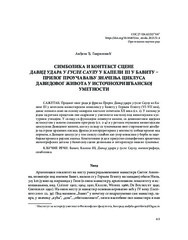Prikaz osnovnih podataka o dokumentu
Симболика и контекст сцене Давид удара у гусле Саулу у Капели III у Бавиту – прилог проучавању значења циклуса Давидовог живота у источнохришћанској уметности
Symbolism and context of the scene David playing the harp before Saul in Chapel III at Bawit – a contribution to the study of the meaning of the David cycle in Eastern Christian art
| dc.creator | Гавриловић, Анђела | |
| dc.date.accessioned | 2023-12-29T20:51:23Z | |
| dc.date.available | 2023-12-29T20:51:23Z | |
| dc.date.issued | 2023 | |
| dc.identifier.issn | 0352-6844 | |
| dc.identifier.issn | 2787-3099 | |
| dc.identifier.uri | http://reff.f.bg.ac.rs/handle/123456789/5932 | |
| dc.description.abstract | Предмет овог рада је фреска Пророк Давид удара у гусле Саулу из Капеле III у коптском манастирском комплексу у Бавиту у Горњем Египту (VI–VII век), данас позната само на основу акварела насталог почетком XX века (сл. 1). У питању је једна од ретких представа ове садржине у уметности насталој под византијским културним утицајем. У складу са функцијом поменуте капеле, са доминантним идејама истакнутим у њеном сликаном програму (сл. 2–4) и у ретким очуваним византијским циклусима Давидовог живота, као и у складу са тумачењима овог старозаветног догађаја од стране црквених писаца, фреска је интерпретирана у контексту победе врлине над пороком, а Давидов циклус је у том смислу схваћен као узор монасима у борби за задобијање врлина и рајских насеља. Констатовано је да и присуство специфичних архаичних иконографских детаља у бавитској сцени дозвољава и поткрепљује овакво тумачење. | sr |
| dc.description.abstract | This paper deals with the fresco depicting Prophet David Playing the Harp before Saul from Chapel III in the Coptic monastery complex at Bawit in Upper Egypt (6th–7th century). Today, it is known only from a watercolour painted at the beginning of the 20th century (Fig. 1). It is one of the rare representations of this subject in art created under Byzantine cultural influence. Taking into consideration the function of this chapel, the central idea of its painted program (Figs. 2 and 3), the David cycles in Byzantine art, as well the Old-Testament interpretations of the Church Fathers, the fresco has been explained in the context of the victory of virtue over vice, and the cycle of David is understood in this sense as a model for the monks in their struggle to acquire virtues and attain the Kingdom of Heaven. The presence of specific archaic iconographic details in the Bawit scene supports this interpretation. | sr |
| dc.language.iso | sr | sr |
| dc.publisher | Матица српска (Нови Сад) | sr |
| dc.rights | openAccess | sr |
| dc.rights.uri | https://creativecommons.org/licenses/by/4.0/ | |
| dc.source | Зборник Матице српске за ликовне уметности 51 | sr |
| dc.subject | Бавит | sr |
| dc.subject | Капела III | sr |
| dc.subject | Давид удара у гусле Саулу | sr |
| dc.subject | иконографија | sr |
| dc.subject | симболика | sr |
| dc.subject | Bawit | sr |
| dc.subject | Chapel III | sr |
| dc.subject | David playing the harp before Saul | sr |
| dc.subject | iconography | sr |
| dc.subject | symbolism | sr |
| dc.title | Симболика и контекст сцене Давид удара у гусле Саулу у Капели III у Бавиту – прилог проучавању значења циклуса Давидовог живота у источнохришћанској уметности | sr |
| dc.title | Symbolism and context of the scene David playing the harp before Saul in Chapel III at Bawit – a contribution to the study of the meaning of the David cycle in Eastern Christian art | sr |
| dc.type | article | sr |
| dc.rights.license | BY | sr |
| dc.citation.epage | 75 | |
| dc.citation.issue | 51 | |
| dc.citation.spage | 63 | |
| dc.identifier.doi | 10.18485/ms_zmslu.2023.51.4 | |
| dc.identifier.fulltext | http://reff.f.bg.ac.rs/bitstream/id/14737/bitstream_14737.pdf | |
| dc.type.version | publishedVersion | sr |

